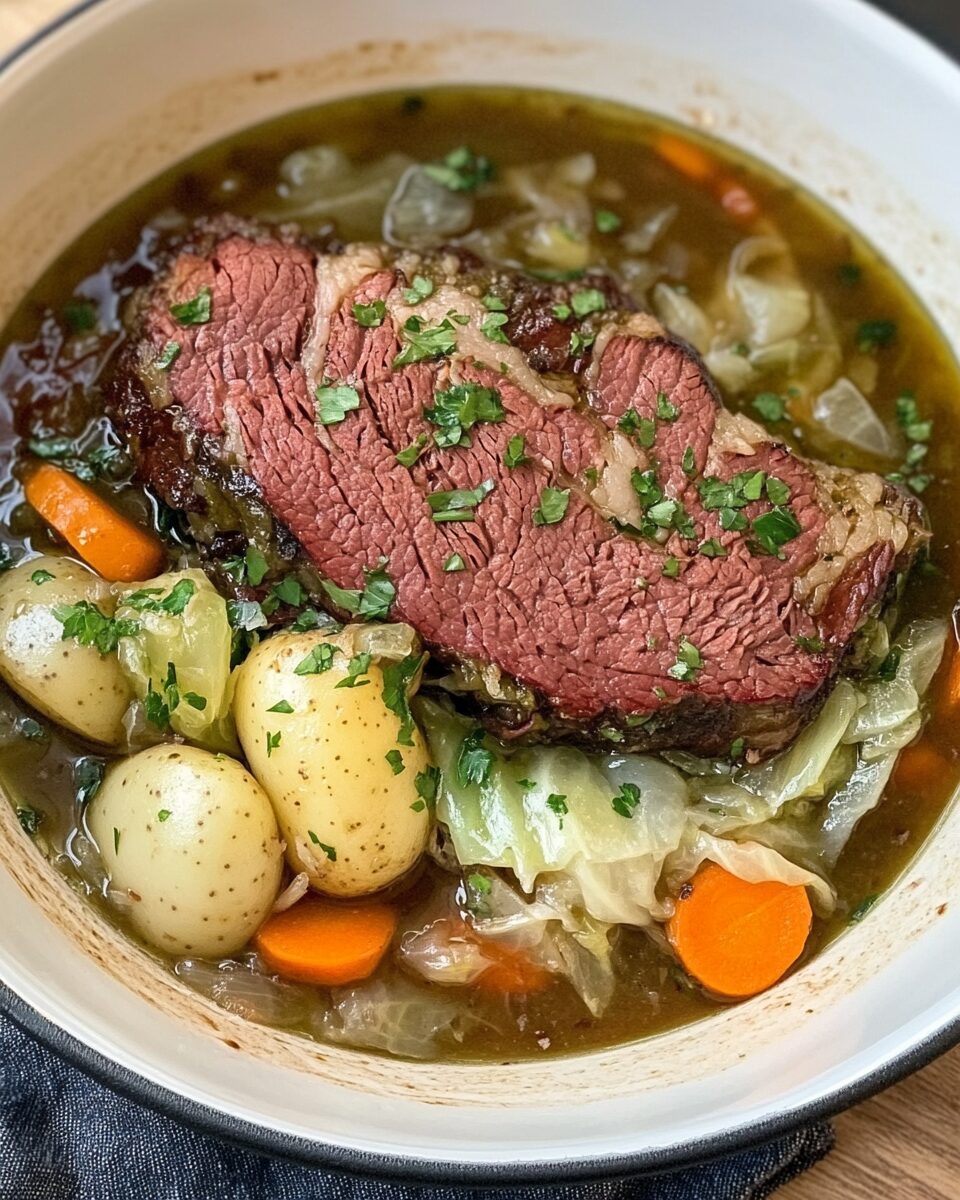The Irish Boiled Dinner is a deeply traditional meal that evokes the warmth and heart of home cooking. With tender, slow-simmered corned beef nestled among hearty white potatoes, carrots, cabbage, and sweet onions, this dish is simple yet rich in flavor and heritage. It’s perfect for a comforting family meal or a celebration of Irish culture.
A staple during St. Patrick’s Day festivities and cherished in kitchens around the world, this one-pot meal offers incredible ease without sacrificing taste. The slow cooking process infuses the vegetables with savory richness while keeping the beef succulent and juicy. Leftovers? They’re perfect for soups or sandwiches the next day.
Full Recipe:
-
1 (3 to 4 pound) corned beef brisket, rinsed
-
Water (enough to cover beef by 6 inches)
-
3 whole onions, peeled
-
6 carrots, peeled and chopped
-
1 small head of cabbage, cut into wedges
-
6 medium white potatoes, peeled
Directions:
-
Rinse the corned beef brisket under cold water and place in a large stockpot.
-
Add enough water to cover the roast by at least 6 inches.
-
Add the whole peeled onions to the pot.
-
Bring the pot to a rolling boil and cook for about 30 minutes.
-
Reduce heat to medium-low and maintain a gentle boil. Cover and cook for 3 ½ hours.
-
Remove the onions, cut them into wedges, and return them to the pot.
-
Add carrots and arrange cabbage wedges over the roast.
-
Place potatoes on top of the cabbage. Cover and cook for about 30 more minutes, or until potatoes are fork-tender.
-
Remove the vegetables and place them in a serving bowl.
-
Keep the corned beef in the pot until ready to slice and serve to maintain moisture.
Prep Time: 15 minutes | Cooking Time: 4 hours | Total Time: 4 hours 15 minutes
Kcal: 540 kcal | Servings: 6 servings
The Hearty Legacy of Irish Boiled Dinner
The Irish Boiled Dinner is a time-honored dish that represents more than just comfort food—it’s a culinary tradition passed down through generations. Although commonly associated with Ireland, particularly during St. Patrick’s Day celebrations, this dish has a unique and complex story shaped by history, immigration, and adaptation. In the United States, Irish Boiled Dinner is often synonymous with corned beef and cabbage, a pairing deeply rooted in the Irish-American experience rather than the traditional fare of rural Ireland.
This beloved one-pot meal brings together corned beef, cabbage, potatoes, onions, and carrots—all slowly simmered until each ingredient is tender, flavorful, and infused with the seasoned broth. The simplicity of the recipe belies its rich depth of flavor, making it a go-to meal for those craving warmth, nostalgia, and a taste of the old world.
The Irish-American Connection
One of the most common misconceptions is that corned beef and cabbage is a staple from Ireland. In reality, while cabbage and potatoes were certainly foundational ingredients in the Irish diet, corned beef was not widely consumed in Ireland due to its cost. Instead, pork—particularly bacon—was the preferred meat for most working-class families.
When Irish immigrants arrived in the United States in the 19th century, they encountered corned beef as an affordable alternative to the bacon they were used to. Often purchased from Jewish butchers in urban neighborhoods, corned beef quickly became a practical and delicious stand-in for traditional cured pork. Over time, Irish-American communities embraced the dish and paired it with cabbage and root vegetables, creating the boiled dinner we know today.
This fusion of Irish cooking techniques with American ingredients became a cultural icon—a symbol of heritage, resilience, and adaptation.
A Dish Rooted in Simplicity and Resourcefulness
One of the enduring appeals of Irish Boiled Dinner is its simplicity. The ingredients are basic, affordable, and widely accessible—perfect for large families or those cooking on a budget. Yet, despite its humble components, the dish manages to deliver a deeply satisfying meal that feels both rustic and refined.
The method of boiling—rather than roasting or frying—ensures that the meat stays moist and the vegetables are gently infused with flavor. The resulting broth becomes a rich, savory elixir that ties the entire meal together. In homes where nothing goes to waste, that leftover broth is often repurposed for soups or stews the next day, stretching the value of the meal even further.
Why It’s More Than Just a St. Patrick’s Day Meal
While the dish sees a surge in popularity around March 17th, its appeal extends far beyond a single holiday. Irish Boiled Dinner is ideal for Sunday family dinners, cozy weeknight meals, or celebratory gatherings. Its versatility and ease of preparation make it suitable for both novice cooks and seasoned chefs looking for a comforting, no-fuss classic.
In fact, many families make this meal a weekly staple during colder months. The long, slow simmering warms the kitchen and fills the home with an irresistible aroma. Each bite offers a mix of hearty textures—the tender beef, buttery-soft potatoes, and subtly sweet cabbage all harmonizing beautifully in every mouthful.
Cultural Significance and Nostalgia
Food has the power to evoke memory and emotion, and few dishes do this better than a well-made Irish Boiled Dinner. For many, it recalls childhood meals with grandparents, bustling family kitchens, and stories of ancestors who traveled across oceans in search of a better life. It’s a meal that ties generations together, whether served at a holiday table or a simple family supper.
Its cultural symbolism is especially strong among Irish-American communities, where the dish serves as a living connection to heritage. Sharing this meal, whether at home or in a communal setting, becomes a way to honor tradition and express pride in one’s roots.
Pairings and Serving Suggestions
To elevate the Irish Boiled Dinner experience, many cooks serve it with traditional condiments such as whole grain mustard, horseradish cream, or a tangy vinegar-based sauce. The sharpness of these sides cuts through the richness of the meat and complements the sweetness of the vegetables.
Some also like to add rye bread or soda bread to the meal, providing a crunchy contrast to the tender components of the boiled dinner. A light lager or Irish stout is a classic beverage pairing, though a simple herbal tea or cider also pairs wonderfully.
For dessert, something simple and hearty like apple cake, bread pudding, or scones rounds out the meal beautifully.
Modern Twists on a Classic Favorite
While traditionalists may prefer to stick with the original recipe, there’s no shortage of creative adaptations for the modern cook. Some people swap the white potatoes for sweet potatoes or use purple cabbage for a more colorful presentation. Others might roast the vegetables after boiling them briefly to add a caramelized edge.
For a lower-sodium version, many opt for uncured brisket or use a homemade corned beef cure. Plant-based adaptations using jackfruit, tempeh, or seasoned seitan also make this dish accessible to vegetarians and vegans while preserving its core flavors and heartiness.
Slow cookers and Instant Pots are also commonly used to cut down on active cooking time while preserving the traditional texture and taste. These methods are perfect for busy home cooks who want to serve up something soulful without spending hours at the stove.
Storing and Repurposing Leftovers
Irish Boiled Dinner is one of those rare meals that tastes even better the next day. Store leftovers in airtight containers in the refrigerator for up to 4 days, or freeze for longer storage.
The leftover meat makes excellent sandwiches—try it on rye with mustard, sauerkraut, or cheese. The vegetables and broth can be combined into a quick soup or reheated with additional herbs for a light but comforting lunch.
Some home cooks even turn leftovers into a savory hash, pan-frying the diced meat and vegetables together with butter or olive oil for a hearty breakfast or brunch dish.
Conclusion: A Dish That Tells a Story
Irish Boiled Dinner is more than just a plate of corned beef and cabbage. It’s a story of immigration, adaptation, family, and the enduring power of comfort food. It celebrates simplicity while offering deep flavor, and it provides a tangible connection to the past in every bite.
Whether you’re preparing it for St. Patrick’s Day or a quiet Sunday evening, this dish brings people together. It’s a meal that nourishes both body and soul—an edible reminder that the best recipes are those made with heart, shared with loved ones, and rooted in tradition.








